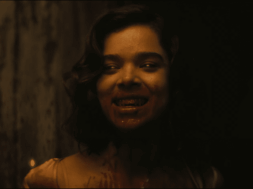‘The House on Sorority Row’ and ‘Sorority Row’ Fulfill Different Horror Cravings [Revenge of the Remakes]
Mark Rosman‘s The House on Sorority Row (1982) and Stewart Hendler‘s Sorority Row (2009) feel shoved aside in their respective horror classes. Titles like Pieces, Black Christmas, and The Dorm That Dripped Blood get more frequent mentions when discussing pre-90s sorority or dormitory slashers. Remake debates rarely include Sorority Row in their reassessments of unfairly stigmatized 2000s horror revamps based on nostalgia biases (among other reasons). It’s interesting how both seem equally less popular despite their amassed cult followings after meager box office openings.
It’s almost like Hendler attempted to shake the original’s mojo by deeming Sorority Row an adaptation of Rosman’s screenplay Seven Sisters — the earlier iteration of what would become The House on Sorority Row. Don’t mind the trickiness because Josh Stolberg and Pete Goldfinger write their re-imagining indebted to The House on Sorority Row. Maybe late-2000s remake fatigue led to the marketing position in an attempt to separate Sorority Row from trolls screaming for more originality in horror cinema (countless remakes showcase creative originality, don’t get me started)? It’s undoubtedly farther removed from The House on Sorority Row than The Hitcher is from Robert Harmon’s inaugural ride or Quarantine from Spain’s infinitely scarier outbreak — but we shouldn’t shun its remake merits.
The Approach
Mark Rosman’s position as Executive Producer on Sorority Row doesn’t mean there’s a preciousness about following The House on Sorority Row like a blueprint. Josh Stolberg and Pete Goldfinger pen a script that differentiates itself with an introduction that implies alternative killer motivations, passages of time, and deeper contemplation of soul-eating secrets. Rosman torments his sorority sisters over a few nights and empowers fertility experiments gone haywire — Stewart Hendler oversees how bonds built under traumatic secrecy eventually crack over long periods. Sorority Row takes an idea and speculates further, where The House on Sorority Row crams as much murderous mayhem and Hitchcockian mystery into a single end-of-year serving.
In Sorority Row, Meghan (Audrina Patridge) is missing — or that’s what the sisters of Theta Pi want authorities to believe. Jessica (Leah Pipes), Claire (Jamie Chung), and Chugs (Margo Harshman) initially defend their Theta bestie by pranking Chugs’ brother Garrett (Matt O’Leary) because he’s a terrible boyfriend to Meghan (atop countless other frat-pest offenses). Unfortunately, Meghan’s fake-out overdose ends in actual death when Garrett plunges a tire iron into the sorority hottie’s supposed corpse. Cassidy (Briana Evigan) insists the Theta’s phone an ambulance, but Jessica demands guilty parties take the secret to their graves lest their post-graduate years be spent in prison. Everyone holds the information until graduation day, when a threatening picture message and the appearance of Meghan’s sister causes Theta Ellie’s (Rumer Willis) wits to crumble — then bodies start hitting the floor.
Both films are byproducts of their eras, definable by the celebratory liquor and booze toasts in each iteration. The House on Sorority Row circles its ladies as they jokingly rib but adore one another, while Sorority Row uses the ceremonial pre-game to highlight the problematic bitchiness of its backstabbing, shit-talking characters. Rosman’s adoration of 1955’s Les Diaboliques stresses suspenseful investigations as Katey (Kathryn McNeil) pieces together clues that lead to a jester-dressed manchild under the prude Slater’s (Lois Kelso Hunt) care. Hendler approaches villain stalks more linearly like I Know What You Did Last Summer or Scream, where it’s more about faces in a crowd and the spectacle of 2000s horror era slayings. The original implements morbid hallucinations and psychological unrest, while Summit Entertainment’s remake hacks through bodies without grand conspiracies or further embellishment.
Does It Work?
Sorority Row emblemizes how nastier 2000s horror remakes approached their ruthless reinvigoration of older-school titles. Where The House on Sorority Row features DC-based powerpop band 4 Out of 5 Doctors and a sillier subplot where blind date Peter (Michael Kuhn) gets continually drunker throughout the unbelievable night, Sorority Row fixates on mean girls, predatory men, and heaping spoonfuls of atonement through brutality. Mark Rosman’s vision is more about the chase and speculation turning into this looming specter, where Josh Stolberg and Pete Goldfinger execute storytelling that’s hellbent on punishment. The House on Sorority Row asserts Vicki (Eileen Davidson) as the coverup mastermind so that we can sympathize more with her sorority accomplices. Sorority Row implicates everyone immediately — in the latter, we’re rooting for deaths from the shocking roofies-and-voyeurism prank introduction.
Stewart Hendler leans into the pettiness and dysfunction of Greek life traditions, from slut-shaming to scathing disses about physical appearance. Sorority Row has no filter (positively and negatively), which leads to hilarious moments as Pipes accentuates the shallow mercilessness of Jessica when making jokes about Meghan’s death. She’s the Vicki replacement and performs well beyond her comparison because Sorority Row lets its Theta Pi sweeties act like frat bros would in any other reductive slasher about collegiate stereotypes. The men of Sorority Row are all sharks sniffing blood from HR nightmare in training Mickey (Maxx Hennard) to horny psychiatrist Dr. Rosenburg (Ken Bolden) — and they’re handled by the killer’s pimped-out mechanic’s weapon. Stolberg and Goldfinger lay an exploitative foundation that skewers disturbing fraternal behaviors a decade before 2019’s Black Christmas would do the same, even if their methods can be a bit abrasive in the name of authenticity.
There’s an assertive 2000s horror sheen about Sorority Row that stands proudly alongside The Texas Chainsaw Massacre (2003), Friday the 13th (2009), and others I’ve covered thus far on “Revenge of the Remakes” — but also honors since-ousted 80s slasher signatures. Hendler doesn’t shy away from nudity, introducing Theta Pi with a pajama pillow fight party where a trampoline-hopping attendees’ bare rump flashes to all. There’s more flesh in Sorority Row than I’ve seen in the last three years worth of horror releases, as well as cringey-but-perfect needle drops that again summon a rather 80s attitude of treating horror like this after-midnight party. No one’s shy about their intentions with Sorority Row, as the film achieves a rarer blend of ferocious 2000s slasher intensity while still channeling freer 80s boundaries that loved sex, blood, and rock n’ roll.
The Result
Sorority Row is a sinfully entertaining remake about drunkards, fornication, and the unspeakable horrors of upper-class white America. From the very first shot of house mother Mrs. Crenshaw (Carrie Fisher) sipping on alcohol — this isn’t old lady Slater — to Crenshaw’s badass shotgun rampage, Stewart Hendler recalls slasher remakes like Silent Night (2012) and Black Christmas (2006) that upgrade massacre sprees. Tremendous strides are taken to separate the more familiar hunt-and-gut Sorority Row from Mark Rosman’s vastly more complicated The House on Sorority Row, as cattiness becomes a calling card that makes Mean Girls look like Kindergarten Yo Momma. Scummy pools are swapped for overheating hot tubs, a very House Of Wax (2005) finale goes up in flames, and there’s no grand reveal of bodies despite the chilling image of sunken souls in The House on Sorority Row that remains seared into my memories.
Then again, despite what the creators behind Sorority Row claim, it’s a remake of The House on Sorority Row. Homages and callbacks are sprinkled throughout, from a broken top-floor window during the film’s opening to Cassidy’s beak-tipped cane weapon when she attempts to rescue Claire. A steamy shower encounter recalls Jeanie’s (Robin Meloy) bathroom decapitation. Rosman University is dedicated to Mark Rosman because without The House on Sorority Row, there’d be no Sorority Row. Hendler ensures there’s “justification” behind a remake that never dares replicate the almost soapy mad scientist Slaughter High vibes of The House on Sorority Row because a good remake drags its source kicking and screaming into contemporary relevance — for better and/or worse.
Special Effects Coordinator Steve Riley nails the gruesomeness of spectacle deaths that outshine the humble bloodletting in The House on Sorority Row. Chugs’ wine bottle deepthroat in Sorority Row is an all-time slasher elimination, as the glass vessel fills with choked-up blood after the killer slices her throat. Visual effects also accentuate the grim practical artistry, specifically when Claire eats a blistering-hot flare that boils her facial skin like overcooked cheese pizza. Hendler’s cast teeter-totters between despicable and sorrowful (typically back to despicable), and the twist is an outlandish commentary on the hubris of performative nice guys. Yet, Sorority Row most successfully lives up to its 00s slasher bargain of remakes with infinitely outdone death sequences. The House on Sorority Row has fun impaling hilariously fake dummies on much tighter budgetary limits — Sorority Row makes its transgressors agonizingly pay for their actions, excelling in grotesqueries that distract from missing Rosman’s more intricate puzzle.
The Lesson
Sometimes you want to watch Grade-A trash get every fatal stab, blunt force trauma, and punctured artery they deserve. Sorority Row is the remake with no flippin’ mercy that undergoes a total attitude makeover — appreciation will vary in that regard. My column isn’t about which release I prefer, because there’s more to remakes and originals than rankings. The House on Sorority Row and Sorority Row fulfill different cravings of horror cinema and pose quite the contrasting yet complementary double-bill. Two deadly collegiate slasher sprees showcase opposite methods of subgenre expression, from the familial whodunit with ponderous investment to the kill-em-all assault hinged on grosser and more elaborate demises. Both fun, both frantic, neither canceling the other’s existence.
So what did we learn?
● Josh Stolberg and Pete Goldfinger have my trust as writers of multiple successful remakes.
● The remake/original spectrum continues to be best served with decades between and titles entrenched in their historical periods of horror movements.
● Plays smart like My Bloody Valentine (2009) in the way it does not replicate an existing twist but generates its own shock value by unmasking a different killer with new motivations.
● I erased “The House on Sorority Hill” multiple times because it’s all my fingers wanted to type.
Sorority Row feels ahead of its decade in how it subverts slasher expectations like women being helpless fawns and men getting away with sleazy behavior as locker room heroes. I’m not saying it’s a flawless commentary given multiple caricatures like Chugs’ debauchery or Jessica’s Queen Beotch crown, but I wonder how audiences would receive Sorority Row today. It’s an inversion of fraternity horror films — or helpless female horror flicks — that’d possibly be lauded today for its punkish desire to prove girls can be just as demeaning, lewd, and horned-up. Then again, there’s no way something this skin-forward and faithful to T&A 80s midnighters would hit screens today. Whether caught in the remake storm or held as an antidote for the ongoing trauma-latent horror wave, I’m not sure there was ever a favorable window to release Sorority Row — and for that renegade reason alone, I’m glad this delinquent slasher exists.
In Revenge of the Remakes, columnist Matt Donato takes us on a journey through the world of horror remakes. We all complain about Hollywood’s lack of originality whenever studios announce new remakes, reboots, and reimaginings, but the reality? Far more positive examples of refurbished classics and updated legacies exist than you’re willing to remember (or admit). The good, the bad, the unnecessary – Matt’s recounting them all.













